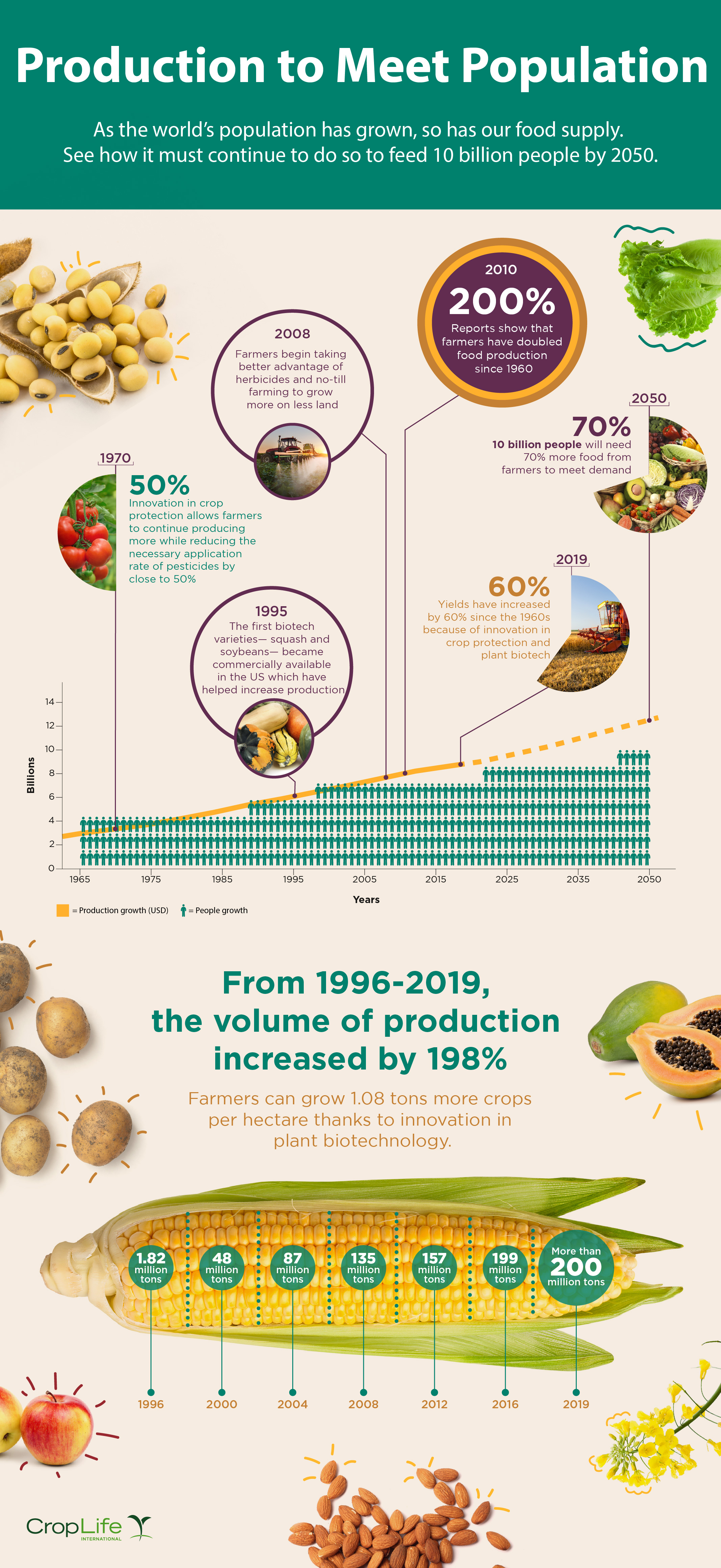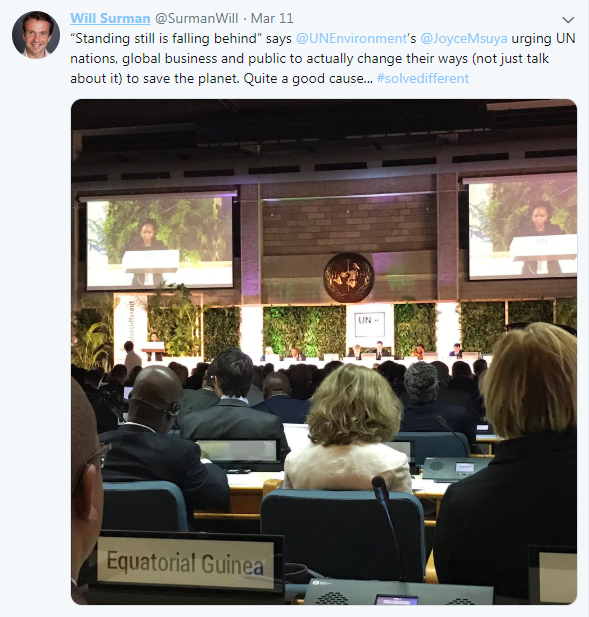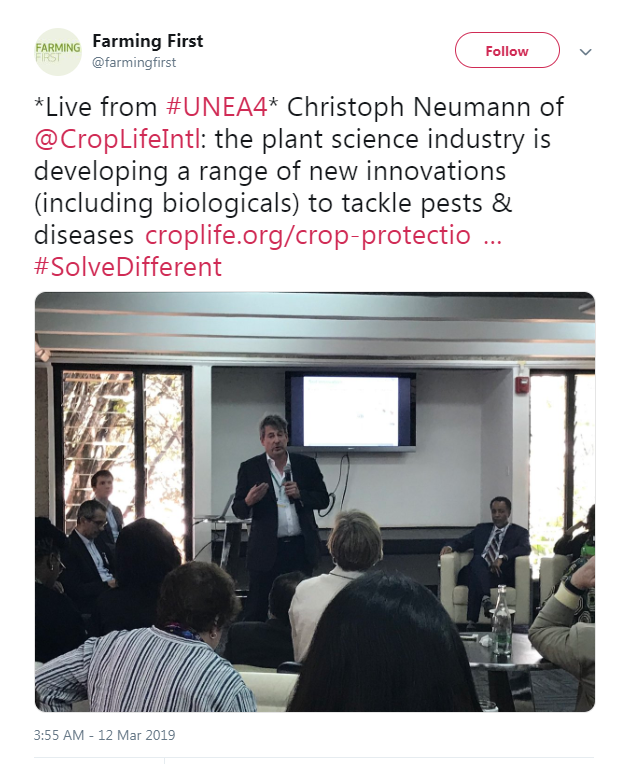
Category Archives: Latest News
HOW IS PLANT SCIENCE HELPING TO SAFEGUARD CROPS AGAINST CLIMATE CHANGE?
By: CropLife International
The world is changing fast, and we must adapt. Read how plant scientists and farmers are leading the way in ensuring the world’s food is secure as our environment changes.




MEET GRACE MAKU
By: CropLife International
How plant science can help Ugandans feed their families and increase climate – resilience.
Meet Dr. Michael Otim, a Crop Entomologist at the National Crops Institute. Dr. Otim works in Uganda, where droughts affected close to 2.4 million people between 2004 and 2013.[1] He is part of the Water Efficient Maize for Africa project which is working to develop drought-resistant maize.
This research will be vital for families like Grace Maku’s. Like most Ugandans, Grace Maku and her family rely on the maize they grow on their farm to both feed themselves and be their primary source of income.
As Grace explains, climate change is putting her maize farming at risk:
“DROUGHT SIMPLY DRIES UP THE MAIZE. SOMETIMES WE HAVE TO GET WATER AND TRY TO IRRIGATE, BUT THAT’S NEVER EASY HERE.”
This is where drought-resistant crops could greatly improve her life. Some estimates suggest that drought-resistant maize could reduce up to 25% of crop loss. Innovations like this are essential to ensuring we meet the 2030 Sustainable Development Goal on Zero Hunger.
When maize is successfully harvested, it is often milled at places like Nakatundu Maize Millers in Kiwenda, Uganda. Over two million Ugandans count on maize as their main source of income, with agriculture accounting for almost 30% of the nation’s GDP.[2]
Mitigating the impact of climate change and drought on crops like maize would mean increased demand for millers and increased economic activity – benefiting all Ugandans.


From Dr. Michael Otim’s lab, into Grace Maku’s field, all the way to Agnes Makilumda’s (pictured above) table, maize’s journey from the field to the plate is an important one
As global climate continues to change, and it becomes harder to harvest maize and other crops through drought, floods, and other natural disasters, biotech can help ensure our food’s journey is not interrupted.
CARING FOR THE ENVIRONMENT THROUGH INNOVATION
By: CropLife International
Last month, CropLife International attended the 4th session of the United Nations Environment Assembly (UNEA) in Nairobi, Kenya. Policy makers, businesses and third-sector organizations from across the globe came together to discuss the environmental challenges our planet faces, and how sustainable innovation could be the key to solve these.

One area we’re passionate about is improving soil health. We joined the UN Food and Agricultural Organization, the International Fertilizer Association and the UN Environment Programme (UNEP) at a side event to talk about the importance of healthy soils to ensure food safety, food security and human health.
CropLife International’s Director of International Regulatory Affairs for Crop Protection, Christoph Neumann, spoke about how new innovations in plant science can help tackle pests and diseases, while also ensuring soil health.

He also spoke about the importance of no-till agriculture – the practice of planting a new crop directly into the stubble of the previous crop, without ploughing. Intrinsic to the use of no-till is the use of herbicides to control weeds.
No-till helps to maintain soil structure, improve the ability of soil to retain water and every year it prevents the release of CO2 equivalent to removing every car from London for 5 years.
Christoph explained how investment in research on natural pesticides, known as biologicals, is another major area of innovation to help farmers deal with the pest threats to our harvests and crops.
We also joined the UN Environment Programme which urges more action on chemical management. We support UNEP’s new report, Global Chemical Outlook II (GCO II), which calls for efforts to ensure chemical management is in line with the Sustainable Development Goals. You can read more about how the industry actively supports GCO-II here.

Partnerships was another major them at UNEA. I sat on a panel event organised by UNEP where we discussed the value of public private partnerships to deliver sustainable development. I spoke about how we have worked with the German development organisation, GIZ, and the Vietnam government to help thousands of rice farmers towards a better future.
As Joyce Msuya, Assistant Secretary General and Active Executive Director of the United Nations Environment Programme, articulated: “Standing still is falling behind”. We must all work together to come up with new solutions to fight today’s environmental challenges – through collaboration across businesses, governments, citizens, and NGOs.

GROWING A SUSTAINABLE FUTURE
By: CropLife International
Jake Leguee is a third generation family farmer in Saskatchewan, Canada. He grows several crops on his land including canola, wheat, durum, peas, lentils, and soybeans. We visited Jake during the harvest season to learn how he practices sustainable farming.
Jake and his family farm 13,000 acres, which is around 35 miles from one side to the other. This means the farm has many different land types and weather patterns.
Like many other farmers, weather is one of the biggest challenges that Jake faces on his farm. But with the right tools there are lots of things he can do to tackle this: “if we can maximize the crops water-use efficiency, we can make the best use of the weather we get. And the best way to do that is with good varieties, good nutrition, and taking care of pests in the crop.”
Jake follows integrated pest management (IPM) principles to ensure that he manages pests on his farm sustainably. Learn more about Jake and IPM here.
HOW PLANT SCIENCE IS HELPING TO FEED ETHIOPIA’S CITIES
By: CropLife International
How can we secure food for growing urban populations? Take a look at how CropLife and our partners are helping to feed Ethiopia’s cities:
And learn more about these smallholder farmers here.
GERMAN HOPS HERO
By: CropLife International
German beer is famous around the world. Most brewers in Germany still follow a 500-year old recipe that combines water, hops, malt and alt yeast.

Most German hop farms have been in families for many generations. Meet one of our food heroes- Georg Selmeier, a sixth-generation hop farmer. As his experience has taught him, hops are very vulnerable to pests and disease — “Every year we have a new challenge”.
And that’s where crop protection can help!

Florian Weihrauc is a plant scientist at the Hop Research Institute. He’s working to help farmers protect their hops from damage – he explains that knowing when to apply crop protection products is a crucial part of preventing disease.

“Take downy mildew. Because we know the disease, we developed a forecasting model that gives a control threshold that tells farmers when they need to spray fungicides, using as little as possible, but as much as needed to protect the crop.”
It’s research and tools from Florian and his colleagues that keep hops healthy and German beer flowing.
Cheers to our #FoodHeroes for working together to keep harvests healthy, so there’s more beer for everyone!

Read more about our hops and our German #FoodHeroes here
WHAT DO POTATOES, CORN AND PEANUTS HAVE IN COMMON?
TOP 10 FOODIE ACCOUNTS TO FOLLOW
Food is at the heart of what we do, follow our top ten twitter accounts to hear what these foodies have to say:
![]()
Dave Chang
Follow chef @davidchang, founder of Momofuku — group of restaurants in the US.
![]()
Carla Hall
Follow @carlahall, co-host on “The Chew,”a popular lifestyle series. She has competed on multiple cooking shows and believes food connects us all.
![]()
James Wong
Follow @Botanygeek British-Malaysian botanist with a special interest in food crops who teaches about plants, food & horticultural science.

![]()
Michael Smith
Follow @ChefMichaelSmth, FoodTV host, cookbook author and official food ambassador for Prince Edward Island.

![]()
Dennis Littley
Follow @AskChefDennis, a food & travel blogger, chef, and speaker based in Orlando.
![]()
Michele Payn
Follow @mpaynspeaker, she is an agriculture focused entrepreneur growing the farm and food conversation and founder of Cause Matters Corps.
![]()
Chris Osburn
Follow @tikichris, a London-based food and travel blogger.
![]()
Camilla Hawkins
Follow @FabFood4All, she runs the UK-based food blog Fab Food 4 All where she blogs about food and shares recipes.
![]()
Russ Parsons
Follow @Russ_Parsons1, former food columnist for the LA times and author of How to Pick a Peach & How to Read a French Fry.
![]()
Sudhvir Singh
Follow @sudhvir, Oslo-based physician and Policy Director at EAT forum – The science-based global platform for food system transformation.
BEST REPORTS FROM THE PAST 12 MONTHS
As 2019 gets underway, we want to make sure that you’re equipped with the most up to date information on plant science in sustainable agriculture. So we have created a list of the most influential reports published over the last 12 months. Take a look to make sure you didn’t miss any!
![]()
A Special Report on the Impacts of Global Warming
Global Warming of 1.5°C: Intergovernmental Panel on Climate Change (IPCC)
This United Nations report looks at the predicted impact of global warming of 1.5°C above pre-industrial levels and related global greenhouse gas emission pathways, in the context of strengthening the global response to the threat of climate change, sustainable development, and efforts to eradicate poverty. It established, among other findings, that “populations at disproportionately higher risk of adverse consequences with global warming of 1.5°C and beyond include local communities dependent on agricultural or coastal livelihoods”.
![]()
Report of Projected Insect Pressure Increases
Increase in Crop Losses to Insect Pests in a Warming Climate: Deutsch, Tewksbury, Tigchelaar, Battisti, Merrill, Huey, and Naylor
Climate change causes erratic weather patterns, extreme temperatures, and changes in natural resources. This report adds increases in insect pressure to crops to the list of things farmers have to worry about if temperature rises by two degrees Celsius above pre-industrial levels. Under this scenario, farmers could lose 59 billion kilos of wheat –more than the entire wheat production in the US in 2017, 92 billion kilos of rice, and 62 billion kilos of maize.
![]()
Annual Update on Status of Biotech Crops Around the World
Global Status of Commercialized Biotech/GM Crops in 2017: ISAAA
The International Service for the Acquisition of Agri-biotech Applications (ISAAA) released its annual global biotech crop acreage report, which features data on the environmental and socio-economic benefits of plant biotech. ISAAA reported that the adoption of biotech crops has reduced CO2 emissions by 27.1 billion kg and conserved biodiversity by saving 22.5 million hectares of land from agricultural use in 2016.
Additionally, in developing countries, planting biotech crops has helped alleviate hunger by increasing the incomes for millions of smallholder farmers and their families, bringing improved financial stability to more than 65 million people.
![]()
Pesticide Safety, Investment, Efficacy Trends Report
Evolution of the Crop Protection Industry Since 1960: Phillips McDougall
This report demonstrates how pesticides have improved since 1960. A more diverse portfolio is available for farmers to fight crop pests of all sorts and as the growth of the sector continues, the safety and efficacy have increased while toxicity of the products has decreased.
![]()
Analysis of The Current Position of Agriculture in the EU
The Challenges Facing Agriculture and The Plant Science Industry in the EU: AgbioInvestor
This report analyses the European agricultural sector’s productivity, policy and support, regulatory environments, and reliance on imports. It highlights the obstacles put in place by a political system that does not prioritize agricultural innovation and shows the consequences of reduced access to modern agricultural tools.
![]()
More Land Needed to Farm Organic Food than Non-Organic
Assessing the Efficiency of Changes in Land Use for Mitigating Climate Change: Searchinger, Wirsenius, Beringer & Dumas
In this report, published by Nature International Journal of Science, it was confirmed that farming organic food can result in higher emissions and greater land use due to loss from pests and lower yields. Biodiversity and carbon sequestration are important in the fight against climate change, and preserving land while feeding a growing population can be achieved with agricultural innovation like plant biotechnology and crop protection.
![]()
Post-Brexit Possibilities for Regulation of Plant Biotechnology
UK Plant Genetics: A Regulatory Environment to Maximize Advantage to the UK Economy Post Brexit: Brookes, 2018
This paper examines the economic value of the UK plant genetics sector and the most appropriate regulatory environment for maximizing long-term benefits to the UK economy outlined in three scenarios: continued regulatory alignment with the EU, improved implementation and some change; making the current GMO system work “as intended”, or the UK sets its own path of divergence from EU regulations on GMOs.
![]()
Review of Genetically Engineered Crops Safety Information
Food and Feed Safety of Genetically Engineered Food Crops, by Delaney B, Goodman RE, Ladics GS
This article reviews the safety information regarding Genetically Engineered (GE) crops and foods, by evaluating over 20 years of research in genetic engineering. Like the issue statement, it is based on the premise that although new GE crops are assessed by regulatory authorities prior to approval for commercial use, there is still a public debate on the safety GE crops.
![]()
A Review of The Benefits GMOs Have Afforded Brazilians in the 20 Years Since Adoption
20 Years of GMOs: Environmental, Economic and Social Benefits in Brazil: CIB, Agroconsult
2018 marked the 20th anniversary of the introduction of GM crops in Brazil. The country is the second largest adopter of biotech crops globally on more than 50 million hectares of farmland and agriculture is one of the most dynamic industries within the country. To quantify the benefits of GM crops in the country, a conventional crop and a GM crop were compared, year by year, to assess the technical nuances of use of pesticides, the differences in production costs, and the financial results of one system verses the other.
![]()
A Study Quantifying Economic and Social Benefits from Timely Regulation of Ag Biotech Products
The Impact of Delays in Chinese Approvals of Biotech Crops: Informa Agribusiness Consulting Group
The 2018 study quantifies the wide-reaching social and economic benefits both importing and exporting countries could realize if timely and functional regulatory systems were in place. Delays in the regulatory process—including delays in innovations reaching the marketplace – impede global initiatives to improve food and nutrition security, advance economic prosperity, and increase the adoption of environmentally sound practices.
 Literature review Shows Benefits of Tech to Smallholder Farmers
Literature review Shows Benefits of Tech to Smallholder Farmers
The Role of Technology in the Future of Smallholder Agriculture: CropLife Foundation
The role of technology to improve smallholder-based food production systems has been written about extensively. CropLife International worked with the CropLife Foundation to provide a literature review to better understand how modern agricultural technologies can improve smallholder livelihoods. The review found that of a variety of factors, risk was paramount in influencing the adoption of technology relating to irrigation, genetic resources, pest management, and conservation agriculture among others.
You can also view our top 10 studies for 2017, 2016, and 2015.










